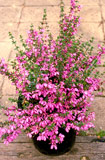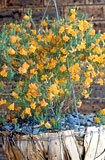|
[Front Page] [Features] [Departments] [Society Home] [Subscribe]

Getting Started 8: Potted Plants
Based on a series of short article aimed at the new grower of Australian native plants. The original series was written by the late Arthur Cooper and appeared in the newsletter "Native Plants for New South Wales" in the early 1970s. It was subsequently updated and reprinted in the same newsletter in 1990-91.
More and more Australian native plants are being grown in pots, window boxes and other containers.
There are several reasons for this. Some lovers of these plants have grown past the age of strenuous gardening; some live in home units and the like. Some want to grow species which are not suited to the conditions in their gardens. For instance, they want to grow dry-climate plants in a high rainfall area or frost tender species in a cold district. Others have a similar but harder problem. They want to grow susceptible plants in a district where the soil is too contaminated. For example, they may wish to grow lechenaultias (which will grow for years in pots but which die within a year in most east coast gardens).
Growing in pots is only a matter of re-potting the plant instead of planting it out in the garden so that at all times it has enough soil and space for it to grow healthily. This is satisfactory for plants which are small or which don't live long, but bigger or older plants will eventually reach the largest practicable pot. When this happens you must reduce the demands of the plant. Gently turn the plant out of its pot, tease off the outside quarter of the soil and trim the roots which are thereby laid bare. Clean the pot and replant using fresh potting soil. Having reduced the root system you should prune the plant to reduce the foliage by about the same amount. Use the opportunity to cut out any poorly growing parts of the plant.
The choice of pot is really a matter of personal taste. There is a wide range of plastic pots available in small and large sizes and, you can even use your imagination and use unusual objects such as old hollow stumps and half wine barrels. If you use clay pots, remember that these are porous and lose moisture much quicker than plastic varieties so they will require more frequent watering. As re-potting will be needed, perhaps every year or two, a tapered, rather than a straight-sided pot will lead to least root disturbance.
 |
Colourful, small plants like Tetratheca thymifolia make excellent container plants for a sunny balcony.
Select the thumbnail image or highlighted name for a higher resolution image (41k).
|
Practically any Australian plant which will grow in a garden will grow well in a pot. Many which will eventually be too big for pot growing (Grevillea robusta for example) make good, fast growing subjects in their younger days. Growing a plant in a pot does not usually transform it into an indoor plant. They can be brought indoors during flowering, of course, but they should spend most of their lives in the fresh air. Many species which are of rainforest origin, however, will survive indoors for very extended periods.
It's easy to protect potted plants from infection and well worth doing. Make a strict rule NEVER to stand your potted plants on the bare earth; ALWAYS stand them on something impenetrable, such as a sheet of plastic. This is not just to prevent soil pathogens from getting into the potting mix. If you are growing particularly hardy species in containers standing on bare earth, they will quickly take root into the soil through the drainage holes.
Always use clean pots. If you are re-using a pot scrub it thoroughly and then disinfect it using a diluted solution of household bleach (about 7 parts water to 1 part bleach). It is a good idea, and if you are growing difficult species it is almost essential, to use a quality potting mix designed for Australian native plants. You can buy it in sealed bags from reliable nurseries.
What is "AFP?"
AFP is "Air Filled Porosity". This is the fraction of air in a mix after it has stopped draining. It is an important factor for container grown plants because, if there is too little air (as in mixes comprised of very fine particles), plants will "drown" and the mix will become "sour". This is often the result when straight garden soil is used as a potting mix.
Standard methods of measuring AFP are available but, to get a rough idea of the AFP of your potting mix, try this:
- Take a 150mm pot and calculate its volume (the size is not critical but you must use the same pot for all tests as AFP is influenced by the depth of the pot).
- Compact the mix into the pot and submerge the filled pot in a bucket of water for an hour or so.
- Quickly lift the pot out of the bucket and support it over an empty container to collect the drainage water.
- Measure the volume of water collected after about an hour. This volume represents the amount of air that has now entered the mix.
- Calculate AFP (%) as:
Volume of water ÷ Volume of pot x 100
Generally the AFP measured in this way should be around 20%.
|
| |
|
Your potting mixture must be open textured. A good reference on potting soils generally is the CSIRO's booklet "Potting Mixes" (No.9 in the "Discovering Soils" series). The principle in the CSIRO's approach is to have a balance between water holding properties and air in the root zone of the plant. You can increase the amount of air in the mix by adding coarse material such as gravel (5-10 mm particles) or pine bark chips which have been stored and watered frequently for about six weeks to remove potentially toxic compounds (see box - "What is AFP").
All container plants will require feeding because any nutrients not taken up by the plant will be leached out of the potting mix by water flowing through it. Overfeeding is obviously wasteful for this reason. A slow release ferilizer applied at the rate recommended on the pack will ensure a gradual release of nutrients over time. Most native plants don't require any special fertilizer formulation, however, some are sensitive to excess phosphorus and should be fertilized with special "native plant" fertilizers. These have a lower phosphorus concentration that general fertilizers. For a discussion of phosphorus-sensitive plants see Phosphorus Needs of Australian Plants in the December 1997 issue. As a rough guide, use low phosphorus fertilizer on any members of the Protea family (Grevillea, Banksia, Hakea, etc).
|
|
Watering is best done by taking the pot and immersing it in a bucket of water for a few minutes. However, this can be time consuming for more than two or three pots and totally impractical for any containers greater than about 250 mm diameter. It you do use a hose for watering be careful not to allow the mix to dry out. If it does, it can shrink away from the sides of the pot fractionally and subsequent hosing will just see the water flow down the sides and not soak into the root ball.
If you have a lot of container plants and you plan to go away from home for an extended period, consider installing an automatic watering system with one or two drippers fitted into each pot.
 |
Lechenaultia species can be short lived in humid climates but many, such as this orange form of Lechenaultia formosa are very successful in hanging baskets.
Select the thumbnail image or highlighted name for a higher resolution image (35k).
|
Pests and other troubles with potted plants are not greatly different from those of garden plants. Most of the well-known ones attack them, but you have the advantage of being able to see and get at them quicker and more effectively.
Finally, don't be afraid to try something a bit different. For example, few people would think of growing an "Old Man Banksia" (Banksia serrata) in a large tub because it just seems too big a plant. Surprisingly, it does quite well and makes a very interesting feature. Also try some lechenaultias in hanging baskets....they look spectacular.

[Front Page] [Features] [Departments] [Society Home] [Subscribe]
Australian Plants online - March 2000
Association of Societies for Growing Australian Plants
|